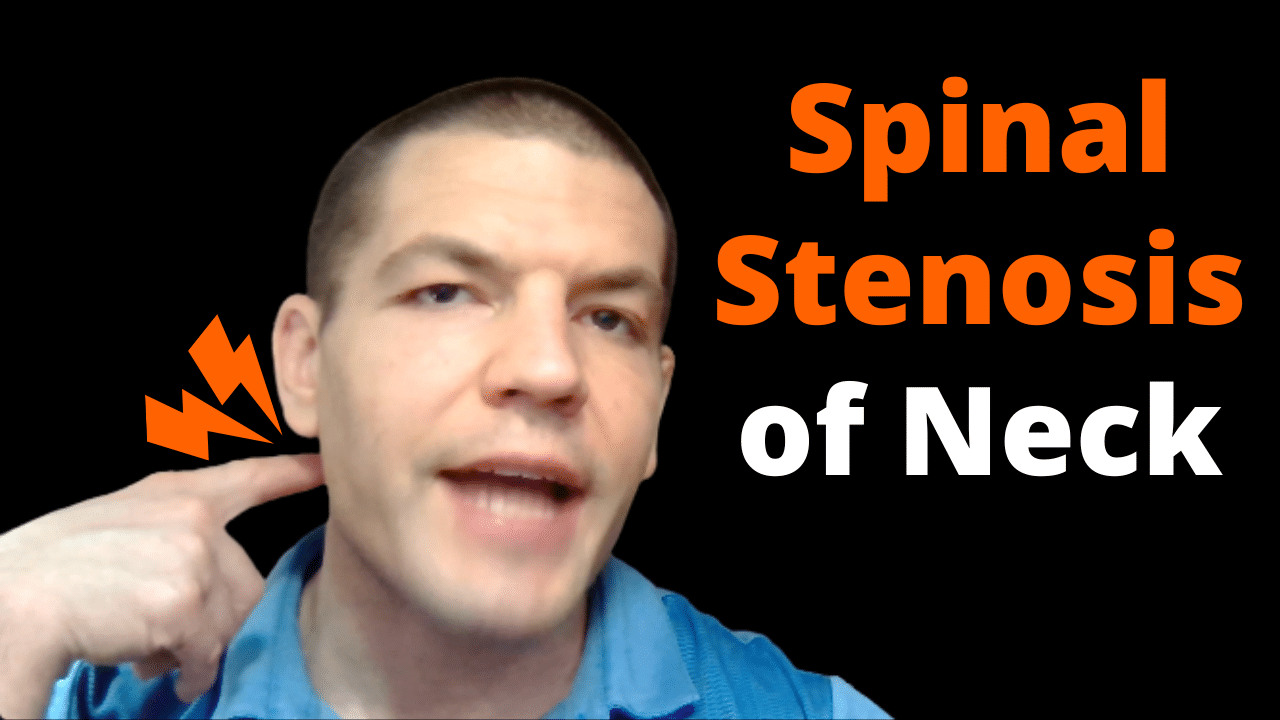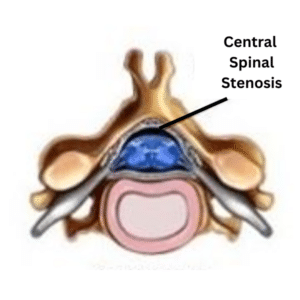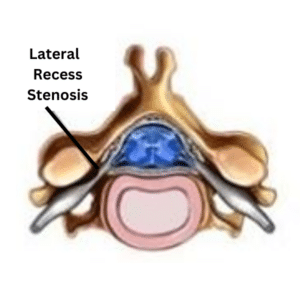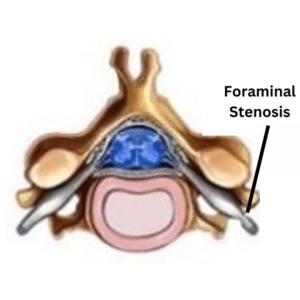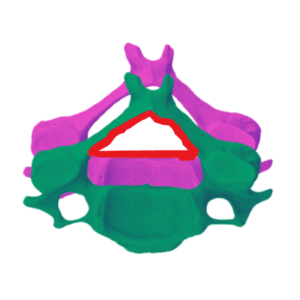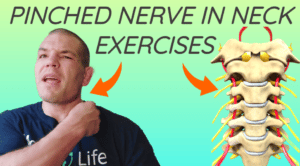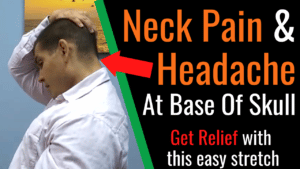What Are The Symptoms Of Spinal Stenosis Of The Neck?
If you've been recently diagnosed with spinal stenosis in your neck, or cervical spinal stenosis (which is the medical term for it), it can be kind of a scary word, especially if you start Googling it and looking it up on the internet.
Watch the video to learn:
- what it really means to have spinal stenosis in your neck
- what the different types of spinal stenosis you can have in your neck are
- the symptoms of those types of spinal stenosis
- plus how to know if it's serious and what you need to do about it.
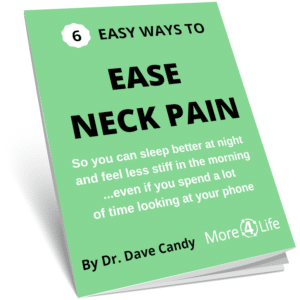
What Is Cervical Spinal Stenosis?
The term stenosis is a medical term meaning narrowing of a space. Therefore spinal stenosis means narrowing of the spaces in your spine where either the spinal cord or the nerves run.
Cervical is the medical term for neck.
Therefore cervical spinal stenosis is the a narrowing of the spaces in your neck around the spinal cord and/or C1-C8 nerve roots.
3 Kinds Of Spinal Stenosis Of The Neck
There are three different types of spinal stenosis of the neck depending on where the narrowing occurs:
- Central canal stenosis
- Lateral recess stenosis
- Foraminal stenosis
I'll explain a little further in the sections below what each of those means. But just know that "spinal stenosis" isn't just one thing.
Each type of spinal stenosis of the neck has different symptoms. Furthermore, the treatment for spinal stenosis can vary depending on the variety that you're dealing with.
Central Canal Spinal Stenosis
Central canal stenosis, which is a narrowing of the space around the spinal cord.
It's the narrowing of the central canal that runs from your head down through your spine.
Of the 3 varieties of cervical spinal stenosis, central canal stenosis is probably the most serious of them.
However, most people who have it don't need surgery for it.
Lateral Recess Spinal Stenosis
Moving out from the central canal, the second type of spinal stenosis is lateral recess stenosis.
The nerve roots that come off of the spinal cord pass through an area between your spinal discs and the pedical, a pillar of bone as illustrated above.
Foraminal Spinal Stenosis
After the nerves go through the lateral recess, they also pass through the foramen or the holes in the side of the neck where the nerves exit the spine.
If those spaces are narrowed, then that's called foraminal stenosis.
Spinal Stenosis Of The Neck Symptoms & Treatment
Most cervical spinal stenosis symptoms can be resolved with conservative treatment. There are cases where you may need surgery for spinal stenosis, but those are the exceptions to the rule.
So I'll go over the symptoms of each type of spinal stenosis, as well as the treatment for each.
Central Spinal Stenosis Symptoms
If you have central canal spinal stenosis in your neck, your spinal cord can get compressed. This can cause symptoms such as numbness or tingling in your hands and/or legs, balance problems, or stumbling.
The most common symptom is compression of the spinal cord, which leads to numbness or tingling in your hands and feet.
If you go to the doctor and they check your reflexes, they may be hyper reflexive as well, such as an exaggerated knee jerk reflex.
However, if you're just having mild numbness and tingling and no balance problems, walking problems, or other weird or unusual symptoms, then it's very unlikely that you'll need surgery.
So what is the treatment for central canal cervical spinal stenosis?
Central Spinal Stenosis Treatment
Central canal spinal stenosis is the most difficult of the problems to treat.
That's because the vertebral foramen that that spinal cord travels through is a solid ring of bone.
If you've started to develop bone spurs in that canal, there's nothing that you can do anatomically to wide it short of surgery.
However, surgery in that area is very dangerous because it's so close to your spinal cord that it can cause damage and possibly make your symptoms worse.
The spinal cord damage can cause paralysis or breathing difficulty (if above the C4 level).
Additionally, an injury to the arteries that travel through your neck and to the brain can get injured during surgery, potentially creating risk for a stroke.
Those surgical complications are are, but they can happen.
So, if at all possible, you want to avoid surgery.
Now, although you can't anatomically make widen your spinal canal, you CAN functionally widen it.
If you've got the vertebral foramen of two adjacent vertebra, the space is widest when the holes of the two vertebrae are precisely aligned with one another.
However, if one vertebrae starts to slide forward on the other, the space becomes narrower.
This can happen when sitting with a forward head posture or when looking down at a laptop or a phone for long periods of time.
So the way that you can keep the most available space in your spinal canal is by avoiding postures that further narrow the spinal canal.
You don't need to go overboard with it and cause a military straight neck.
However, if you're in the habit of sitting with a forward head, correcting that habit may help limit your spinal stenosis symptoms.
Symptoms Of Lateral Recess and Foraminal Stenosis
The symptoms of lateral stenosis or foraminal stenosis are fairly similar because they pinch the nerve root that comes off of the spinal cord.
If you have a pinched nerve in the lateral recess or in the vertebral intervertebral foramen on the side of the neck, that can cause numbness or tingling, usually only in your hand or arm.
Symptoms usually don't go down into your legs if it's just a nerve root that's pinched.
How far down your arm your symptoms go depends on the level that the nerve is pinched at.
Depending on the level of the nerve that's pinched, you may have numbness or tingling or you may notice some weakness in your hand or your arm.
Most of these problems don't need surgery. Only when it's gotten really serious would you need surgery for a pinched nerve in your neck.
When you bend your head forward, bringing your head down, it helps open up the spaces between the vertebrae where your nerve roots exit the spine.
Additionally, if you tip your head to the side, it helps open up the spaces on the side that you're tipping away from.
If you only have spinal stenosis in the foramen on one side, you can try tipping your head away from the side where you have symptoms.
However, doing so also narrows the spaces around the never roots on the other side of the spine, so this wouldn't be a good exercise if you have spinal stenosis on both sides of your neck.
Looking down or stretching with your head down opens the spaces on both sides of the neck.
However, you don't want to allow one vertebrae to slide forward on the other when looking down, because that narrows the central canal.
So you want to look down as instructed in this video.
Conclusion
Hopefully, you found this post helpful to learn how to open up the spaces if you do have spinal stenosis of your neck.
Furthermore, hopefully by better understanding the symptoms of cervical spinal stenosis that you may be having, you'll have less fear of needing surgery and be able to take the right steps to recover.
However, if you're dealing with spinal stenosis of your neck, that's not a problem that you want to address you your own.
At More 4 Life, we take pride in educating and empowering our patients to help them understand their symptoms and what they need to do to recover.
Additionally, we use hands-on treatments to help take the pressure off the nerves in your neck.
Need Help For Spinal Stenosis In Your Neck?
If you need help for spinal stenosis in your neck, we'd help you. Just tap the button below to request an appointment with one of our specialists.

